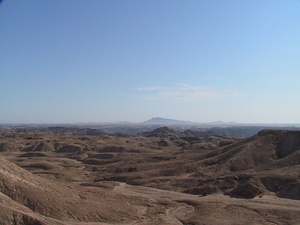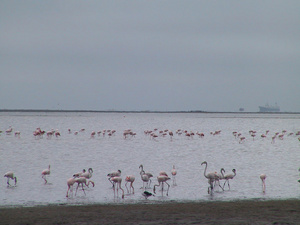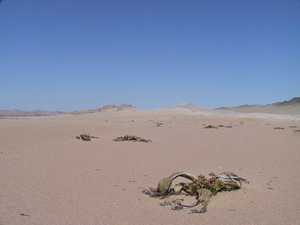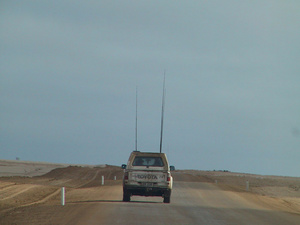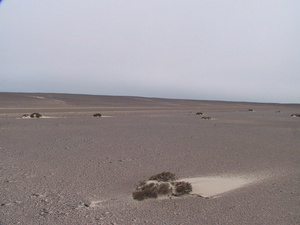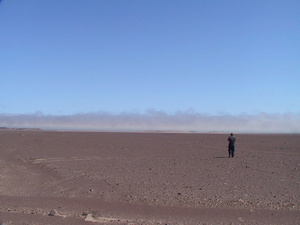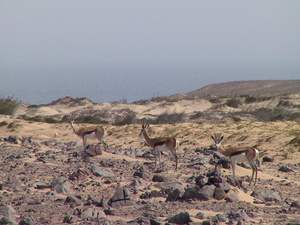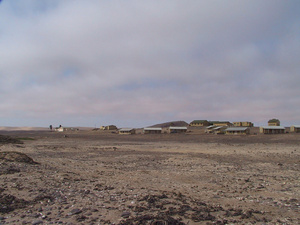Henk Dop: Namibia Trip Report 2005
Swakopmund, Henties Bay, Walvis Bay, Swakop River, Rössing, Terrace Bay, Tora Bay, Skeleton Coast
Friday 29 April: Swakopmund and surroundings; 286 km
Maarten has a sore foot from a misstep at Bloedkoppie, so Marike and I go out alone towards the Welwitschia drive, consisting of various points of interest North and South of the Swakop River. The 'moonscape' is great, with excellent light on the fog, we cross the Swakop which has clearly been carrying quite some water and head for the excellent array of giant Welwitschia's here above the Swakop's right bank.
After a quick lunch Maarten joins us to go and see Walvis Bay (www.walvisbaycc.org.na/). Unfortunately, the tide is low, so the thousands of Flamingo's for which the bay is famous are quite a long way off, and we get no better view when we proceed further down towards the salt works. We drive around Walvis Bay for a bit, which won’t leave any lasting impressions, although the giant 'Jezus alleen' lettering on the tower of the Dutch-reformed church did merit a photo. It's simply a fun morning's drive, we return to camp before noon. Bettina allows me the use of her phone, and I inform Peter from ASCO of what I had done with the tyre problem, we simply agree to talk about it further when we get back.
We do some more shopping in Swakop, to our delight Maarten and I find a nice looking potjiekos cookbook in the bookstore, and Maarten then has to almost physically restrain me when my eye catches the fine collection of Namibiana on display: even a reprint of the famous 1938 Das alte Südwestafrika by Dr. Heinrich Vedder (I have it in a 1966 translation as 'South West Africa in early times' - paid a shitload for it at Foyle's in London)! Marike and I stock up at the Swakopmund Wynkelder (wine cellar) - quite a nice collection there. At camp we clean up the car a bit, something one can actually do daily in dusty Namibia, we fill up the water tank, pay Bettina and are thus ready for an early start tomorrow morning. Around 1730, it's already getting dark, we head back to town to get a takeaway pizza at the Napolitana restaurant. While Marike and Maarten get the pizza's I listen to an Afrikaans evangelical radio station and catch up on all you need to know about 'die Duiwel' en 'die Heere'.
The pizza's smell nice, and are likewise tasty. Driving back through the dark, however, is a sheer nightmare. The headlights of the heavily laden V6 light up a lot of fog, but very little road, leaving me to more or less guess where the road is by the headlights of oncoming traffic. Not again!
Saturday 30 April: Swakopmund - Terrace Bay; 367 km
We leave Sofia Dale at 0715 after saying goodbye to Bettina and camp dogs, a fun Dachshund and Shepherd team. The morning is cold and moist, but the fog fortunately only light. We pass through a still sleepy Swakopmund, and then hit the C34, Namibia’s rather unique coastal road made from salt. With the light fog we don't see much of the landscape, which isn't much of a problem, as there is little enough to be seen. This part of the coast is rather featureless, if an understatement may be permitted. The highlights along the road are various campsites for anglers, and the more permanent settlement of Wlotzkasbaken.
Henties Bay, the renowned Namibian angler's paradise where the wealthier Namibians flock to during the heat of summer (aka 'the suicide season')(www.hentiesbay.com), is briefly entered to top up the tank. Now, out of season, it looks dismally deserted, the few cars that do drive around all carry at least two long fishing rods standing upright in special holding apparatus on the front bumper. We cross the mouth of the Omaruru River which clearly has not run all the way down to the coast this year, and see the Brandberg far off in the distance. No stop at Cape Cross this time: Maarten protests against such an intention. Too vividly does he remember the Sealions' attack on his olfactory bulbs a year ago. OK, so they're a bit smelly ...
The landscape remains featureless, although every now and then when the fog lifts we do get fine views of the surf from the sparse hills. We pass one, and then another Jackal who didn't make it across the road and now lie hideously mangled. Around 1100 we come to the Skeleton Coast Park gate where I check in with the welcoming, punctual and slightly dim-witted attendant. His mind can clearly only focus on one thing at a time, so when the phone rings with one of his buddies at the other end, he exclaims in an irritated voice 'Ek is besig!' While he performs such superhuman feats as figuring out that four N$ 20 bills do indeed make up the required N$ 80, I get a chance to study the ancient natural history display dating back to the South African administration, as well as a fine collection of flotsam, including parts of an airline instrument panel. Perhaps dating as far back as the famed rescue of passengers and crew of the 'Dunedin Star' during WWII?
The attendant doesn't know - and neither did I expect him to. The road stays pretty good, in a slight fog we come to the mouth of the Ugab River where we stop briefly at the lagoon, filled with Cormorants. From an earlier grey, the gravel desert surface now turns brown, sparsely covered with low bushes, with yellow sand collecting in the their wind-shades. We stop for a look at the remains of a wreck - not much left of it. Further up there are more reminders of man's futility in these parts: an abandoned drilling rig, and the attempt at mining at Toscanini, where more Cormorants now use the remains of what was once meant to become a pier.
We now turn slightly inland, and suddenly enter a sunny, wide plain, gently sloping upwards, covered with black gravel, the fog an intense white to our left, spoiling over some low hills, mirages over higher hills to our right. Surely, this must be a different planet. The road winds down again, and now in front of us huge sand dunes reappear, but yellow, not orange as in the Namib Park. The huge road signs at the junction with the road to Khorixas look very much out of place, we head for Tora Bay and back to the coast. Tora Bay, no more than a campsite for anglers, is deserted: it only opens for the suicide season.
Next are the four mouths of the Uniab River, which have once formed a mighty delta, as one can clearly make out. Now only a few puddles can be seen, but that's still enough moisture to make these ancient rivers contrast strongly with their arid surroundings and form unique oases. We see some Springbok, whereas the guidebook states that in good years, even Elephant and Lion are known to come down from the interior.
Once again everything turns quite barren and rocky-brown, we pass the remains of what may have been an attempt at salt-works, then wind up to a hill that looks rather artificial, and indeed, reach Terrace Bay around 1430. Terrace Bay is a former diamond-mining camp, its works long abandoned and the artificial hill consisting of mine tailings. The camp was handed over to the Namibian government, and Namibia Wildlife Resorts now operates this most remote spot as a resort, mainly frequented by anglers. There's some slight confusion at the check-in as a staff-member who's clearly wholly unfamiliar with the proceedings tries to help us out, his well-meant incompetence is then quickly sorted out when a senior colleague arrives. Our patience is rewarded by his remark that NWR's bungling of our booking (we are three, not two as NWR had erroneously copied from my email - for all campsites that's no problem, they go per site, but Terrace Bay is a full-board outfit with prices per person) is their problem, not ours, and we receive the keys for the adjoining bungalows 11 and 12.
Well, perhaps bungalows it too big a word - they're barracks, with a Spartan early-60's interior that has hardly been altered since. The wear and tear and the stains are quite considerable. Still, the beds are comfortable enough, the linen clean, and the shower hot. So why moan, especially as Maarten's bungalow has a brand new fridge?
Marike and I go for a walk along the beach. It's cold and windy, it's fairly tough going on the rounded pebbles and boulders. Who cares about not having made it to Agate Beach at Lüderitz? Marike picks one up every few footsteps, I find a peculiar rounded grey stone with at least a dozen even layers in it, bluish and pink, now in Amsterdam together with the other half a ton of Namibian rocks that Marike had in her backpack on the flight back home. There are Jackal tracks everywhere, as well as Strandwolf and Springbok tracks quite close to the bungalows, evidently to come down and drink from the puddle of vile liquid trickling out of a faulty sewer pipe.
Towards evening the resort comes to life as the resident anglers come back in from their fishing spots. All South Africans, mainly Afrikaans speaking, for whom the delights of this remotest of angling sites obviously outweigh a very long drive indeed. We head for the restaurant, the former canteen, and although not truly a culinary masterpiece, the food is essentially OK. The pork chops may be among the saltiest we've ever tasted, but the pumpkin mash is great. Settling down in Maarten's bungalow for today's notes and a Windhoek (he has three chairs, we only one), we step out every now and then for a 'Strandwolf sweep' with the Maglite. Alas, nothing more than a lone Jackal.

